The Horticultural Side of Chocolate: From Harvest to Dessert
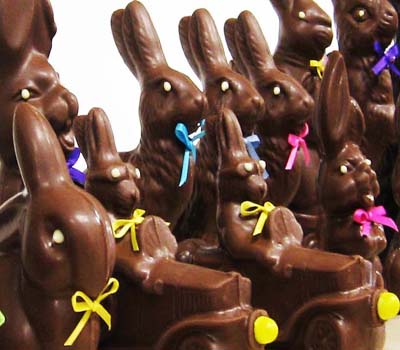
In my previous post, I talked about the particular growing conditions and habit of the cacao tree. Next I’d like to share the details about the processing of the cacao beans – and how it is transformed into one of my favorite desserts.
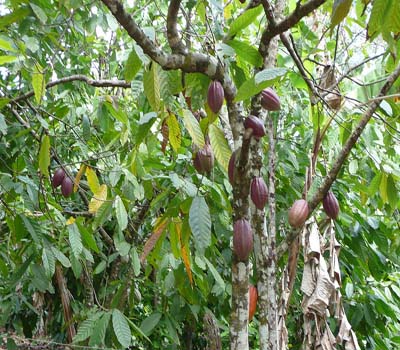
Theobroma cacao tree with mature pods; Creative Commons photo courtesy of Christopher T. Cooper
Once a tree begins producing pods (usually between an age of two to six years), there are many steps involved to produce the chocolate that we see at our local retailers.
First, pods are harvested from the tree: they are individually cut off with machetes. Then, the pods are cracked open, exposing the beans, which are encased in a slimy pulp. The beans are spread out between large leaves so they ferment, which takes five to six days.
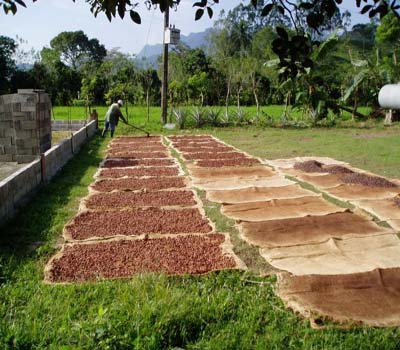
Coco beans layed out to dry in the sun; Creative Commons photo courtesy of Steve DeVries from www.chocolateincontext.blogspot.com
The beans are then dried in the sun for one to two weeks. After that, they are roasted for a couple hours to develop the flavor.
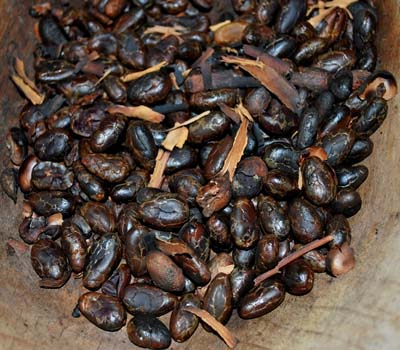
Roasted coco beans; Creative Commons photo courtesy of Wikimedia Commons
A process called winnowing follows, to remove the outer shells. Next, the nibs are ground into a liquid, refining the mixture by removing the remaining husks. At this stage, other ingredients are added in such as sugar, milk, and vanilla.
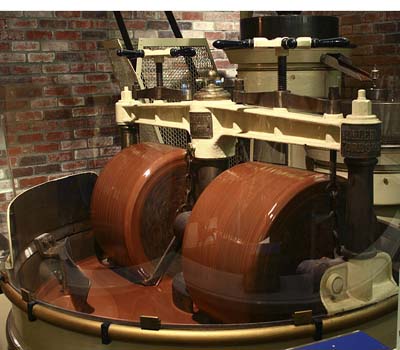
Chocolate melanger mixing other ingredients into the chocolate, such as milk powder, sugar and vanilla; Creative Commons photo courtesy of Sanjay Acharya taken at Ghiradelli Square in San Francisco; from Wikipedia.org
A process called conching further refines the chocolate by breaking down the cocoa and evenly distributing the cocoa butter within the dry cocoa. The longer the conching process, the higher quality the chocolate’s taste and texture become. Low-grade chocolate may be conched for as little as 6 hours. Higher quality chocolate may be conched for two or three days.
There are several large companies such as Ghirardelli, Lindt, Peter’s and Hershey’s who have developed their own manufacturing process to create their signature product. They select the blend of cacao beans and use specific methods of roasting and conching to create a unique taste. Smaller chocolate businesses then purchase bulk chocolate from these companies. Encore Chocolates uses Peter’s chocolate for their hand-made truffles, clusters, and molded creations, like three-dimensional bunnies that hop right off the shelf at a rapid pace this time of year!
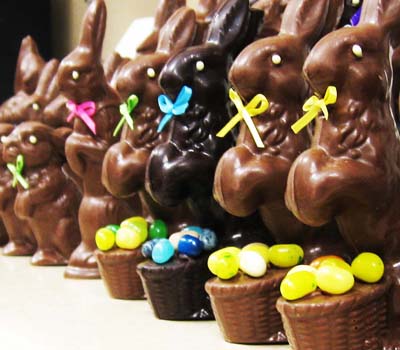
Encore Chocolates' hand-crafted bunnies ready to be packaged; photo courtesy of Encore Chocolates
While chocolate seems to have a ubiquitous presence in our culture, there are an amazing number of specific factors that are essential for producing the final product. Considering the fragile environmental conditions that the cacao tree depends upon, from the rainforest climate to its reliance on the midge to pollinate its flowers, to the diseases that threaten the cacao tree, it’s amazing that the harvests still produce enough chocolate today to meet the world’s demand. Once this precious tree produces fruit, the labor-intensive steps involved from pod to finished product are quite remarkable. Chocolate does seem like an affordable luxury indeed. As our impact on the natural world grows, as economies shift, and as our climate changes, it will be interesting to see what the future of chocolate will be.





No Comments